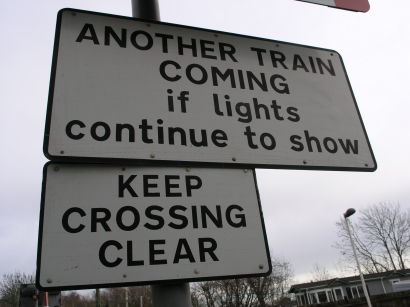THE closure of a level crossing on the East Coast Main Line in Cambridgeshire means Network Rail has now reached its target, set in 2010, of closing 750 crossings by April 2014.
There are now 10 per cent fewer level crossings on National Rail than there were in 2010, but 10 people were still killed on crossings in 2013 and there were also 10 collisions between trains and road vehicles.
Although there is ample evidence that many incidents on level crossings are caused by careless or reckless road users, including pedestrians, Network Rail has also been under fire for shortcomings in its system. There was heavy criticism of the infrastructure owner and its predecessor Railtrack after two teenage girls were killed on the station crossing at Elsenham in December 2005, in spite of existing internal assessments which had warned of risks at the site.
More recently, a woman in a car was killed at Moreton in Lugg in Herefordshire in January 2010 after the local signaller raised the barriers by mistake. It later emerged that there was no 'approach locking' installed, which would have prevented the barriers being lifted when a train was approaching. After this accident, locking was installed at this and many similar crossings.
Network Rail has also just lost its appeal to reduce a fine of £500,000 following a collision in 2010 near Beccles in Suffolk, in which a 10-year old boy was injured. Appeal Court judge Lord Chief Justice Thomas told Network Rail that its directors should 'pay much greater attention to their duties' in connection with level crossing safety.
Network Rail said it has spent £131 million since 2010 on improving crossing safety, partly by building 38 footbridges. Among other measures it has installed spoken 'another train is coming' audible warnings at 57 sites, added barriers at 33 previously open crossings, introduced obstacle detection radar at 13 crossings and fitted cameras at more than 30.
In addition, it is now using GPS to inform signallers about train positions on the Sudbury branch in Suffolk, has installed 250 power operated gate openers to prevent vehicle owners crossing the track on foot unnecessarily or gates being left open, and has also appointed 100 new level crossing managers.
It has also launched a safety campaign with the tag line: "See track, think train". The company has pledged that it will close another 500 crossings im the next five year control period, which starts in April. The Office of Rail Regulation has approved plans to invest more than £100 million in these closures and other risk reduction measures.
Robin Gisby, managing director of network operations, said: “Britain’s railway is safer than ever before, but even so there will always be a certain level of risk to motorists or pedestrians where a road, footpath or cycleway crosses the tracks. Network Rail is committed to reduce that risk as much as possible and if we are able to close a level crossing, we will.
"Reaching our target to close 750 crossings in four years is good news for Network Rail, train operators and of course the public, but we cannot be complacent. There is much more we can do to make the level crossings that remain safer and we will continue to introduce new technology, upgrade crossings to include lights or barriers where appropriate and work with schools, communities and other organisations to spread awareness of our safety message.
"We've pledged to close a further 500 level crossings in the next five years. Successfully closing a crossing isn't always a straightforward process, so we will need the support from local authorities, landowners and the public to help us achieve our new target and improve safety further still."
ORR director of railway safety Ian Prosser said: “We welcome Network Rail’s closure of Cardells crossing in St Neots. To remove 750 level crossings or 10 per cent of their total by April 2014 is a significant achievement for the company.
“Though Britain’s level crossings are among the safest in Europe, there is no room for complacency. They still pose a significant risk.”


